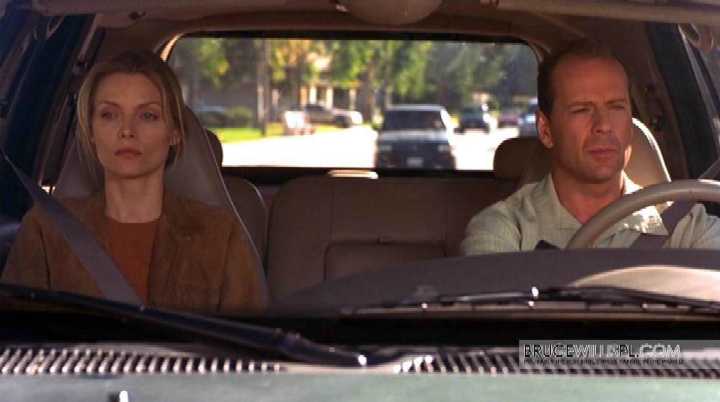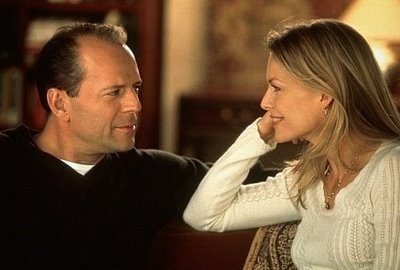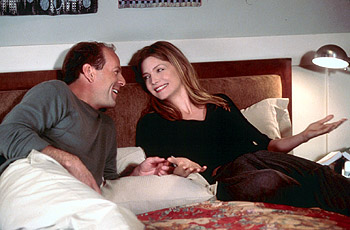Story of Us
The Story of Us
 |
|
| Articles on The Story of Us |
|
|
| Plot Summary |
|
The Story of Us is the very real and humorous examination of Ben and Katie Jordan's marriage. After 15 years, the couple is wrestling with the universal paradox: why are the qualities that made them fall in love in the first place now the very things pulling them apart? Katie Jordan is the designated driver of the marriage. She likes having everything in its place, knowing that there are answers to the little questions and having a sense of closure. Her career as a crossword-puzzle designer fulfills her need to know that the little world on that half page is complete. And this is why Katie fell in love with Ben's imagination, spontaneity and playfulness. Ben Jordan, a writer, is a true romantic who believes in happy endings. But life demands some attention to details, and Ben doesn't know where the medicines are and he lets his washer-fluid light blink incessantly red. Ben's philosophy, as Katie describes it, is comparable to the children's book Harold and the Purple Crayon. Harold is a little boy who draws the world the way he wants it to be and not the way it actually is. Initially they were attracted to one another because they were so very different. Then they had arrived at a point where the very attributes that originally gave liveliness and joy to the relationship have become a source of friction, tension and frequent quarrels. Emotionally drained from their relationship, the Jordans attempt a trial separation while their children, Josh, 12, and Erin, 10, are away at summer camp. For both Ben and Katie, fighting has lately become the condition rather than the exception, and they believe that their only option is a silent retreat to neutral corners. While carrying out that decision they discover a deeper layer of emotional attachment which they cherish and are unwilling to give up. They recognize that their differences represent strengths by which they complement and complete one another. They realize that in the course of living their lives they had forgotten that their relationship and their children are more important than anything else. Ultimately familiarity, friendship, trust and love of their children prevail and they decide to remain together. |
The Story of Us
Directed by Rob Reiner
Written by Alan Zweibel & Jessie Nelson
Starring Bruce Willis as Ben Jordan, Michelle Pfeiffer as Katie Jordan
Copyright belongs to Castle Rock Entertainment
- Wikipedia offers all movie information: The Story of Us
- The Internet Movie Database has information related to the movie and its actors.
- Film details, Videos and other links can be found at the official website The Story of Us
Level 2 Conflict
Relationships at this level are characterized by frequent quarrels, anger, resentment, and emotional confrontations, which make the overall relationship very unpleasant. Partners at this level relate to each other through fear, suspicion, resentment and mutual accusation.
Conflicts and anger arise when our demands and expectations are not met. Harmony arises when we actively strive to accommodate the needs and expectations of the other person. Disharmony raises its head in relationships the moment one or both partners wants to be accepted as and for what they are without having to make an effort or pretense at being better. Before making a commitment, both partners are on their best behavior. Afterwards they may lapse to show their worst. The challenge does not end with courtship, marriage or the honeymoon. It really has only begun. Maintaining harmonious relationships requires constant and continuous effort. The more effort the partners are willing to put into their relationship, the more rewards they get back. Wanting to take and get from the partner without investing sufficient care and effort in the relationship is a sure basis for conflict.
Ben & Katie (The Story of Us)
Some relationships degenerate into intense disharmony after the initial period of getting acquainted is over, or years later when the dullness of routine family life replaces the novelty of the initial period. Ben and Katie Jordan began their married life full of enthusiasm, love and affection for one another. They gave birth to two beautiful children, moved into a comfortable house and achieved financial security. Fifteen years later they found themselves at each other's throats and ready for divorce. Neither of them had a clear idea what had changed or how it had happened. The very traits that they had initially admired in each other had now become a source of constant irritation, conflict and recrimination. Every issue became an occasion to highlight their differences and lapse into arguments.
Like many real life couples, Ben and Katie came to the conclusion that they were no longer compatible or in love. The truth is that they had come to take each other for granted and they had stopped taking the added effort to make each other happy. The initial out-going attitude of joyous self-giving, which is the kindle for romantic attraction, had turned inward and become selfish and self-centered. The very differences they had cherished now reminded each of them of their own insufficiencies. Rather than tolerating their differences and admiring each other as complements, they became defensive and critical.
Ben and Katie had forgotten the simple truth that no human being responds positively to criticism or becomes a better person because they are criticized by others. We become better when we are loved and accepted, never when we are criticized and rejected. Fortunately, they realized before it was too late that neither of them could ever hope to find a better partner than they already had now. By a conscious decision and commitment, they moved back up the scale of harmony striving to recover the sense of romance they had known years before.
Elizabeth & Darcy (Pride & Prejudice)
Some relationships start negatively and move gradually from disharmony to high levels of harmony as the partners get to know, understand and admire one another. Almost from their first meeting, Elizabeth Bennet developed a resentment and prejudice against Fitzwilliam Darcy, when she observed his stiff, aloof social behavior and accidently overheard him tell a friend that he found her appearance only 'tolerable'. Conscious that he comes from a higher level of society and perceiving that he looks down on people with lesser status and wealth, her prejudice grew in intensity each time they met.
In spite of his rude remarks and her inferior social status, Darcy found himself increasingly attracted to her. After much inner struggle to overcome his own objections to a socially disadvantageous marriage, he was finally driven by the passion of his attraction to propose to her. In the course of his proposal, he explained the serious objections to her family which he had struggled to overcome. She took his explanation as an insult and offence, and rejected him. When Darcy demanded to know why she rejected him without explanation, Elizabeth seized the opportunity to accuse him of spoiling her sister's marriage to his friend and cheating Wickham of his rightful inheritance. With each exchange, they both grew more angry and resentful, until she finally declared to him that he was the last man in the world she would ever marry.
The relationship between Darcy and Elizabeth began negatively and remained contentious and resentment for months. Ultimately they each discovered that their disharmony arose from their own egoistic and assertive ignorance, pride, and prejudice, not from real deficiencies in the other person. Elizabeth discovered that the source of her resentment against Darcy was completely unjustified. Darcy realized that he had in fact behaved in a most offensive and ill-mannered fashion. Both had the sincerity to recognize the truth and change their attitudes. When they did so, intense and bitter conflict was transformed into the intense sweetness of romantic love. Their story shows that even intense negativity can be converted into equally intense positive relations when partners are genuine and sincere in their willingness to change themselves, rather than to change or condemn one another.
Maud & Roland (Possession)
English poetry professor Maud Bailey meets American researcher Roland Michell in London and together they strive to unravel the secret romance between two Victorian poets. Neither of the moderns seem made for love and certainly not for each other. They are opposites bordering on contradictions. Bailey is guarded, stiff, irritable, almost frigid British academic, who wants to be addressed as Professor and has a prejudice against all things American. Suspicious of any man’s sexual intentions and eager to avoid relationships, she conceals her beauty to avoid attracting attention to herself. Roland is a casual, friendly, irreverent American who distains British formality. He has had enough of unfulfilling and sometimes hurtful relationships centered around sex and is leery of any intimacy. As they uncover details of the passionate love affair between Ash and LaMotte, the poetry of that relationship infiltrates their cold hearts and awakens a flame of real emotional intensity. Maud’s heart melts and she feels tempted by the lure of sexual relationship. Uncharacteristically, it is Roland who pulls back for fear of spoiling a relationship he has come to value far more than physical pleasure. Maud feels confused and rejected. Her old fears and suspicions of intimate relationship resurface and they quarrel, yet the real basis for their quarrel is their deeper emotional attraction to one another which ultimately prevails. Delving beneath their surface differences, they discover bonds of genuine attraction and admiration that elevate the whole relationship to a far higher level.
To raise your relationship to a higher level of harmony, see Strategies to Increase Harmony in Your Relationship
If you would like to raise general questions on romance, love, marriage and relationship or about any of the content in this article, please post your entry in the appropriate forums
Level 4 - Vital Attraction
Relationship usually begins when one is happy spending time with another, and the attraction has the seal of social approval. He may be attracted to her because of her pleasant manners and behavior. She may be attractive to him because he is considered acceptable or desirable by her friends and family. She takes a personal interest in him which makes him feel good about himself. He may be drawn to her because she is more intense, energetic, more extroverted or having some other attribute that is complementary to his own.
Jane & Bingley (Pride and Prejudice)
Jane Bennet and Charles Bingley are vitally attracted to each other. Jane is a beautiful, sweet, refined young woman. Bingley is a pleasant and happy young man. They are mutually attracted to one another by their good looks and pleasing manners. They feel lost to the world while in each other’s company. His pleasing personality and considerable wealth make him appear most eligible in the eyes of Jane’s family. Jane’s perfect demeanor wins approval from Bingley’s sisters. George Wickham, a dashing officer who charms the heart of every other female in the area has no effect on Jane. Even a year’s separation coupled with the attractions of London cannot sway Bingley’s emotions to forget her. When they come back together, she accepts him happily, almost without unquestioning his long absence. Everyone around them is struck by their quiet, contented joy and confident that their life together will be always smooth and sweet.
A relationship at this level is based on social acceptance or vital attraction to the energies of the other person. Attraction is more social or psychological than physical, though the physical element may still be prominent. We are attracted to partners who are popular or please us. If the attraction is positive and unselfish, the relationship is pleasant and enjoyable, as in the case of Jane and Bingley, who are both mild, well-mannered, likeable and always anxious to please each other. In some cases, one partner may desire to dominate the relationship or both partners may lack the self-discipline and good behavior required to sustain positive relationships. When egoism and selfishness become predominant, the initial vital attraction can degenerate into disappointment, frustration, jealousy, anger and conflict.
Growing in Love (When Harry met Sally)
When Harry met Sally depicts the psychological journey of a man and woman from casual acquaintance and sexual attraction to friendship and emotional intimacy. Harry meets Sally when they share a car ride to New York City upon graduation from the University of Chicago. A few minutes into the trip, the conversation between them becomes heatedly contentious. Harry is strongly attracted to Sally physically. Sally is repulsed by his aggressive manners and obvious sexual intentions. Over the next 13 years they meet repeatedly, then drift apart and meet again. Each passes through many failed relationships. Harry gets married and divorced. Eventually they develop a close, platonic friendship and find that they understand, like and enjoy each other’s company more than any other relationships they have been in. Finally it dawns on them that life together is far happier and more fulfilling than their other romantic pursuits and an intense intimacy grows between them.
Ben and Katie (The Story of Us)
This movie depicts a turbulent period in the relationship between Katie and Ben Jordan, fifteen years after their marriage, when they have two lovely children and a comfortable home in suburbia. He is a carefree, happy extroverted writer; she a well-organized perfectionist who takes life seriously and can only let go in his company. Initially they were attracted to one another because they were so very different. They have arrived at a point where the very attributes that originally gave liveliness and joy to the relationship have become a source of friction, tension and frequent quarrels. They have come to resent the inherited characteristics that each brings from their own family and background. Acceptance of difference has given place to impatience and intolerance. The strong physical and vital attraction that originally made them feel so strongly for one another has gradually worn thin. Although still socially popular with friends, the initial novelty of their individual differences has lost its charm and with it their patience and tolerance for one another. So they decide to separate and divorce. While carrying out that decision they discover a deeper layer of emotional attachment which they cherish and are unwilling to give up. They recognize that their differences represent strengths by which they complement and complete one another. They realize that in the course of living their lives they had forgotten that their relationship and their children are more important than anything else. Ultimately familiarity, friendship, trust and love of their children prevail and they decide to remain together.
The Robarts (Framely Parsonage)
Time and again we find in life and literature that the positive bonds of human relationship possess a commanding power over life. Mark Robarts is an English clergyman living a comfortable and prosperous life on a £900 income with his affectionate wife Fanny and two small children. They resided at Framley Parsonage under the patronage of the elderly Lady Lufton and her son Lord Lufton, who was a longtime close friend of Mr. Robarts. Having attained financial security, a loving family and social respectability at an early age, Mark aspired to climb higher and was lured by the glittering status of the English aristocracy. Though personally charming and well-educated, Mark had led a sheltered life and was ignorant of the ways of the world. As a result, he was easily duped by an aristocratic MP, Nathaniel Sowerby, who persuaded him to sign counter-guarantee on several promissory notes executed by Sowerby on the assurance that he would never be called upon to pay anything against the note. Mark eventually realizes he has been swindled and decides to accept public humiliation rather than borrowing or asking for assistance from his wealthy benefactors.
Mark is vain and foolish, but he is a responsible husband who is faithful and deeply attached to his wife and children. He now finds himself confronted with the onerous task of telling his faithful wife about his catastrophic folly and the public humiliation and severe financial straits to which the entire family would now be subjected. Very rarely in life or literature do we meet a female character like Fanny Robarts. Though a strong English woman and formed individual in her own right, in one respect Fanny resembled far more closely the fading ideal of Indian womanhood. For she considered it her highest duty and greatest privilege to stand by her husband through any ordeal, no matter how severe the trials or how much it may be of his own making. Rather than sit quietly judging him while he confessed his sins to her, she rushed over to stand by his side and demanded the right to share fully the burden that had fallen on his shoulders. Though it did not change the material consequences of his position one iota, Mark immediately felt the burden lifted from his soul by the sympathetic support of a loyal and affectionate wife. Mark and Fanny are saved from infamy and elevated by life at the very next moment when Lufton announces his determination to marry Mark’s sister Lucy. In a trice, the creditors were banished and the Robarts rose through a marriage alliance with the most distinguished family in the county.
Learn unfailing strategies to rise up the scale of romance in your relationship
If you would like to raise general questions on romance, love, marriage and relationship or about any of the content in this article, please post your entry in the appropriate forums


 Ben and Katie’s relationship is an excellent example of Vital Attraction Level 4 in the Scale of Romance.
Ben and Katie’s relationship is an excellent example of Vital Attraction Level 4 in the Scale of Romance. 


